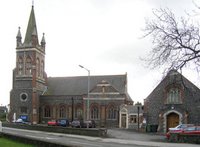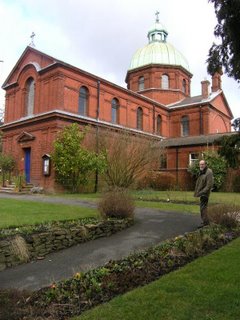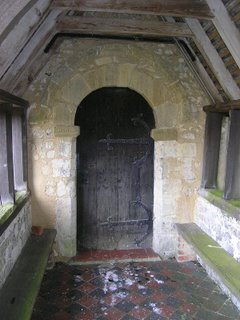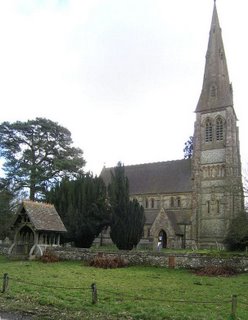ST PETER, PETERSFIELD
I got here first, to find a lady vacuuming the porch. Pevsner calls it one of the most interesting Norman churches in Hampshire, but Sir Arthur Blomfield (bless him!) took things a little further by making some dull victorian neo-Norman "improvements" (clerestory, stepped groups of windows) as well as restoring what was there before. There is a peaceful churchyard to the south, and to the north
 the church presents itself towards a market square which has particularly attractive thanks to thoughtful recent improvements. Unusually the Norman west tower is embraced by the aisles; it has a pretty Perp. top and battlements. The interior of the church was thoroughly restored and reordered in 2000, including repaving and removal of pews. The tower and west bays of the aisles were screened off. I have to say it is among the best reorderings I have seen, and does not spoil your enjoyment of the interior, although there is one strange sight, the top of the former ornate Victorian pulpit on the floor of the sanctuary. Tom says the chancel is virtually disused but the church now serves a variety of functions, including concerts, the accoustics for which the paved floor has vastly improved. All former monuments are gathered in the western bays of the aisles and tower, but were so pre-2000, so Blomfield probably moved it all. There are some very good memorials of the C18, difficult to appreciate for some as they stand in a corridor outside a kitchen leading to the loos. However I witter on, when I haven't mentioned the chief feature, the east arch and internal face of an exceedingly ornate central tower. Traces of work on the north and south sides too, but why so soon was the west tower built and this one seemingly abandoned? Was it ever completed? Norman too the arcade piers, but the rest above looks C19.
the church presents itself towards a market square which has particularly attractive thanks to thoughtful recent improvements. Unusually the Norman west tower is embraced by the aisles; it has a pretty Perp. top and battlements. The interior of the church was thoroughly restored and reordered in 2000, including repaving and removal of pews. The tower and west bays of the aisles were screened off. I have to say it is among the best reorderings I have seen, and does not spoil your enjoyment of the interior, although there is one strange sight, the top of the former ornate Victorian pulpit on the floor of the sanctuary. Tom says the chancel is virtually disused but the church now serves a variety of functions, including concerts, the accoustics for which the paved floor has vastly improved. All former monuments are gathered in the western bays of the aisles and tower, but were so pre-2000, so Blomfield probably moved it all. There are some very good memorials of the C18, difficult to appreciate for some as they stand in a corridor outside a kitchen leading to the loos. However I witter on, when I haven't mentioned the chief feature, the east arch and internal face of an exceedingly ornate central tower. Traces of work on the north and south sides too, but why so soon was the west tower built and this one seemingly abandoned? Was it ever completed? Norman too the arcade piers, but the rest above looks C19.METHODIST CHURCH, PETERSFIELD
There was one place in the little car park which meant we could stop here and visit, as well as
 the church that is opposite. The church dates from 1903, of brick and flint with stone dressings in a Perp style. Big "SW" tower and spire, Petersfield's principle feature, to the right of a seven-light window. To the east a recent extension with community rooms etc. linking the church to its hall (the predecessor chapel?). This was open and from here a door into the church was also unlocked, as people elsewhere were keeping fit by the sounds of things! The interior is disappointing after the outside, a wide rectangular space with an apologetic east apsidal recess, but with a good timbered roof with pendants. The interior here has also been reordered - I bet there were pews here, now there is a sea of liliac upholstered ash chairs, which were all placed on this day facing the "south" wall rather than the apse.
the church that is opposite. The church dates from 1903, of brick and flint with stone dressings in a Perp style. Big "SW" tower and spire, Petersfield's principle feature, to the right of a seven-light window. To the east a recent extension with community rooms etc. linking the church to its hall (the predecessor chapel?). This was open and from here a door into the church was also unlocked, as people elsewhere were keeping fit by the sounds of things! The interior is disappointing after the outside, a wide rectangular space with an apologetic east apsidal recess, but with a good timbered roof with pendants. The interior here has also been reordered - I bet there were pews here, now there is a sea of liliac upholstered ash chairs, which were all placed on this day facing the "south" wall rather than the apse.ST LAURENCE (RC), PETERSFIELD
Stands opposite, and is an Italianite church in miniature. 1890-1, by an architect called Kelly (so
 he was here apparently!). Nothing is known of him and yet he has produced a gem of a building, cruciform with an octagonal central tower and dome. In photos it looks much bigger. Inside nine people were sat quietly at their devotions, and I was so concerned at disturbing them that my flash interior pic is a little out of focus. If you were expecting a riot of colour and fittings, then you would be surprised at the calm tastefully decorated and equipped building. It stays long in the memory yet there is not much else to say about it. (Tom with St Laurence, right)
he was here apparently!). Nothing is known of him and yet he has produced a gem of a building, cruciform with an octagonal central tower and dome. In photos it looks much bigger. Inside nine people were sat quietly at their devotions, and I was so concerned at disturbing them that my flash interior pic is a little out of focus. If you were expecting a riot of colour and fittings, then you would be surprised at the calm tastefully decorated and equipped building. It stays long in the memory yet there is not much else to say about it. (Tom with St Laurence, right)Leaving urban Petersfield behind we headed north on the old main road to Alton.
PRIORS DEAN
We stopped briefly at this church (no dedication known) which Tom knew would be locked - he has never found it open and wonders why it is kept locked and without keyholder information.
 This was to be our only locked church of the day. The north porch shelters a Norman dorway, the floor covered in guano (I am polite aren't I?) and all with an air of impending redundancy or disuse (pic.left). Not so - there is apparently a weekly service here, obviously just for the locals as there is not a single notice to be seen. So we were not able to see the interesting monuments inside which Pevsner records.
This was to be our only locked church of the day. The north porch shelters a Norman dorway, the floor covered in guano (I am polite aren't I?) and all with an air of impending redundancy or disuse (pic.left). Not so - there is apparently a weekly service here, obviously just for the locals as there is not a single notice to be seen. So we were not able to see the interesting monuments inside which Pevsner records.SS PETER & PAUL, HAWKLEY
Now Tom did not plan to come here, but like a kid in a sweet shop having read Pevsner I asked if a visit here was possible and like a good mate it was immediately included in the day. As it was
 we did not detour greatly but it was almost to prove our undoing a little later! The word Teulon will immediately tell other members that here was to be something a little -er- different. In fact we have a complete neo-Norman church, with a "Sompting" style tower with Rhenish helm, nave and aisles under one roof, and chancel with north chapel, all with "crazy-paving" walls. Teulon raises the centre bay of the side walls up like a transept and gives it a wheel window. Inside, and I was immediately chuckling! The cause - firstly absurd arcades with overlarge capitals and the bizarre opening into the side chapel (right) which in turn has a peculiar stone altar, but primarily the continuation of the crazy-paved walls which internally look decidedly odd. Sompting was one influence, but me-thinks Iffley in Oxfordshire was another.
we did not detour greatly but it was almost to prove our undoing a little later! The word Teulon will immediately tell other members that here was to be something a little -er- different. In fact we have a complete neo-Norman church, with a "Sompting" style tower with Rhenish helm, nave and aisles under one roof, and chancel with north chapel, all with "crazy-paving" walls. Teulon raises the centre bay of the side walls up like a transept and gives it a wheel window. Inside, and I was immediately chuckling! The cause - firstly absurd arcades with overlarge capitals and the bizarre opening into the side chapel (right) which in turn has a peculiar stone altar, but primarily the continuation of the crazy-paved walls which internally look decidedly odd. Sompting was one influence, but me-thinks Iffley in Oxfordshire was another.We drove back through Priors Dean on our way to Colemore. Suddenly we were lost, roads divided and divided again and there were no signposts which meant anything. Ultimately we found ourselves at a T junction, no signs, so I guessed left and suddenly we were at Colemore!
ST PETER AD VINCULA, COLEMORE
is in the care of the CCT. Possibly one of the early vestments, it is a church which is nothing special, nave and chancel in one with an early Norman north transept. A twin-rotored helicopter
 appears in my picture dead centre! I wondered if the church would be accepted by the CCT if offered today. Still, that said, it is quite pleasant.
appears in my picture dead centre! I wondered if the church would be accepted by the CCT if offered today. Still, that said, it is quite pleasant.We headed off to find Privett, and came to a main road. It was not the one we thought it was on the map, and we found ourselves heading back to Petersfield. We turned off towards Froxfield in an attempt to find the road to Privett. As we finally found a sign pointing there we also found
ST PETER, HIGH CROSS
which Tom has usually found locked but there seems to be a change of heart here and a small sign proclaims the church is usually open and listing keyholders should people find it locked. It was open. It seems a complete Victorian church, which it actually is, but inside the west three bays of the north arcade are Norman, re-used here after the church at Froxfield was demolished in 1862. (Oddly the church was replaced on the same site in 1887). Externally the church is rather ugly in my opinion, better inside but without much to detain you long (which it didn't).
We took the Privett road, only to find large signs proclaiming "Road ahead closed". So we took a different road, signed East Meon which seemed to be heading in the right direction. Suddenly this road split into three, again no signs anywhere! Tom said straight on without conviction, I said no- lets go right and as I was driving..... In fact all three roads would have brought us down onto the main Winchester-Petersfield road but my choice saved us a few miles! The next target -and my chief visit for coming here today loomed ahead on the hillside.
HOLY TRINITY, PRIVETT
Sir Arthur Blomfield can be really exasperating as an architect, and still has no real recognition even today. His churches often have a production-line quality, and his restoration often gives rise to a dull and lifeless building. Up to now only one church has shown to me what he was capable of when funds allowed, St Mary Portsea (Kingston) in Portsmouth. Here is another, built 1876-8 on the profits of gin and sin it is said, as the benefactors were distillers! (Portsea is 10
 years later.) It is also vested in the CCT, but is not often open apparently although a keyholder is listed as nearby. Tom had arranged for the church to be open, which it was, proclaimed by an open door, welcoming lights inside (to be left on please) and a sandwich board "Church Open". We had a personalised note from the keyholder as well waiting inside. The quaity of the stone and stonework is the first feature you see, you can run your hands down the smooth face of the stone, and the joins are minute. The carved ornamentation and the breathtaking urban scale of this church are amazing. From the 1960s the parishioners had retreated to the south transept and began to sell off its furnishings and fittings. The organ base in the north transept is all that survives of this instrument but the stone font and pulpit do remain. The church has taken on a new life as a concert venue, and consequently a mish-mash of pews and chairs now fill the nave, all brought in from other places.
years later.) It is also vested in the CCT, but is not often open apparently although a keyholder is listed as nearby. Tom had arranged for the church to be open, which it was, proclaimed by an open door, welcoming lights inside (to be left on please) and a sandwich board "Church Open". We had a personalised note from the keyholder as well waiting inside. The quaity of the stone and stonework is the first feature you see, you can run your hands down the smooth face of the stone, and the joins are minute. The carved ornamentation and the breathtaking urban scale of this church are amazing. From the 1960s the parishioners had retreated to the south transept and began to sell off its furnishings and fittings. The organ base in the north transept is all that survives of this instrument but the stone font and pulpit do remain. The church has taken on a new life as a concert venue, and consequently a mish-mash of pews and chairs now fill the nave, all brought in from other places.



No comments:
Post a Comment